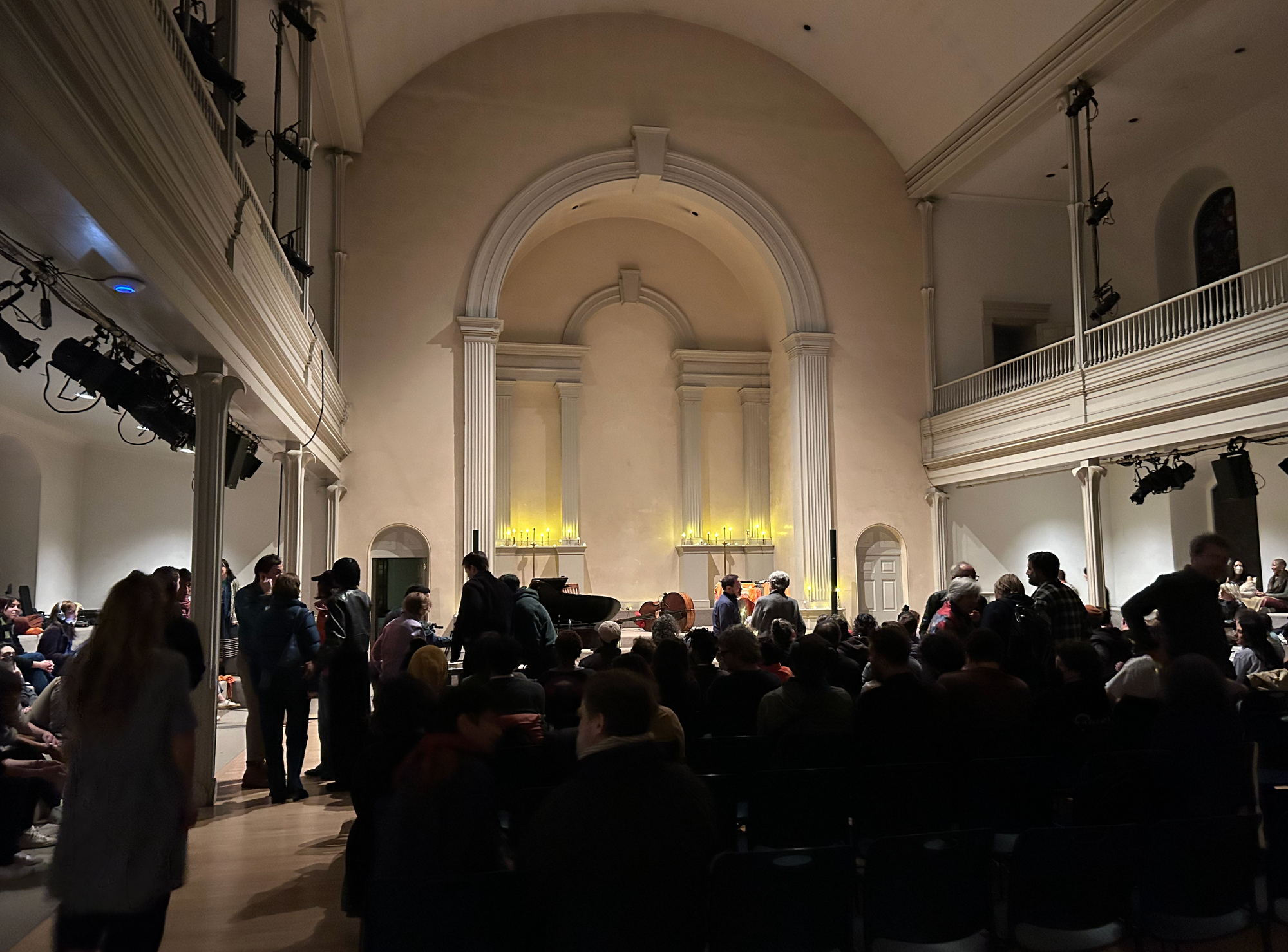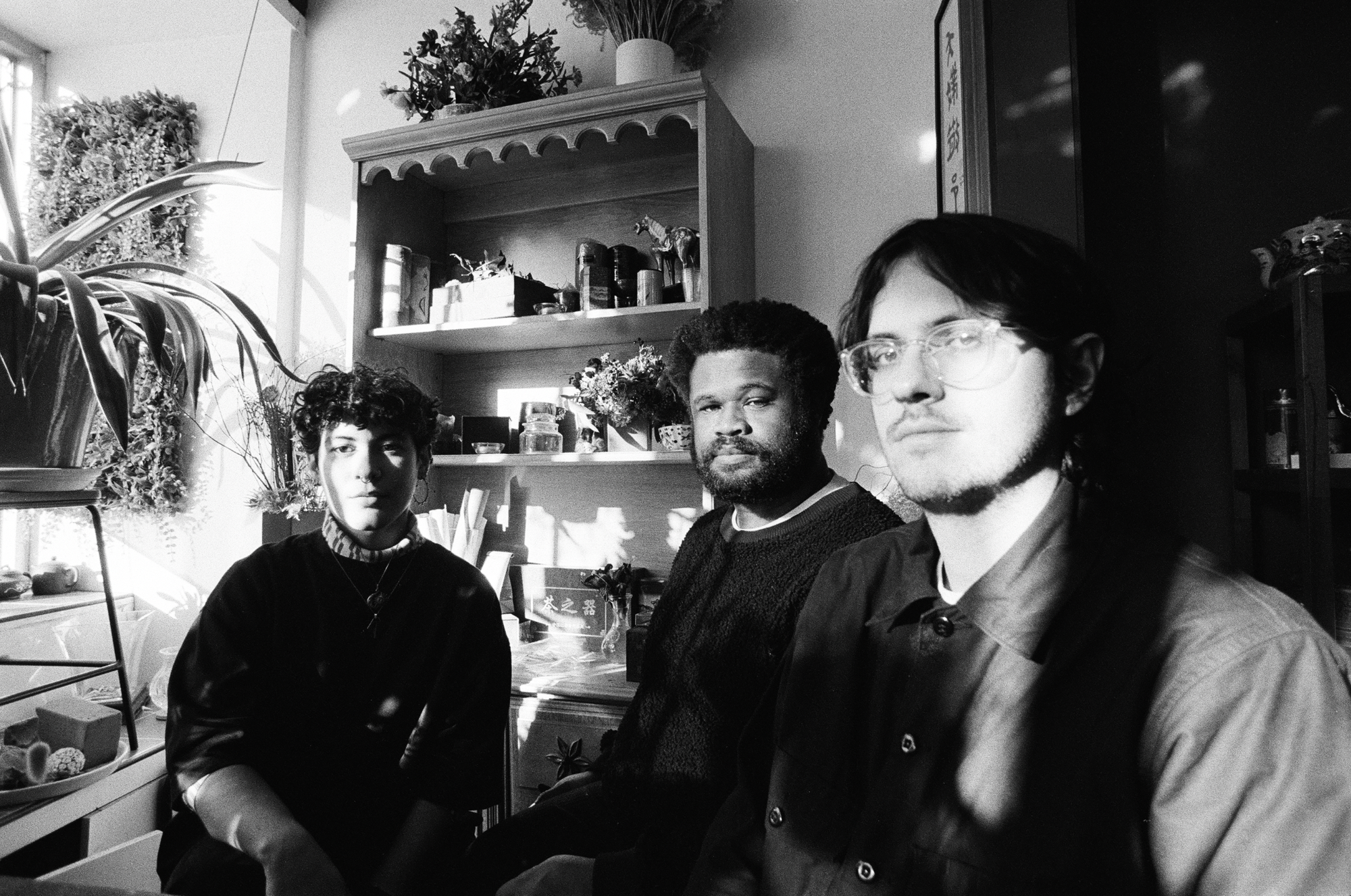descending the indigo western
sky jupiter & our moon adjacent
waxing crescent dipped in earthshine
𖦹
Despite my seven-year relationship with the East Village’s St. Mark’s Church (via The Poetry Project), there are few times I’ve seen a crowd large enough to wrap clean around the courtyard. It was a perfect night on the cusp of spring to come together for a three-act lineup: pianist Thomas Feng interpreting music of the late Emahoy Tsege Mariam Gebru, Brooklyn-based trio sinonó, and the legendary LARAAJI. Organized by Mississippi Records and Dada Strain, the event celebrated the release of Emahoy’s Souvenirs (February 23, Mississippi Records) and sinonó’s la espalda y su punto radiante (March 1, Subtext).
Once inside, the sold-out Parish Hall was buzzing with an air of possibility and magic. I was warmly greeted by my long-time friend Thomas Feng and sinonó’s bandleader Isabel Crespo Pardo, a gentle new acquaintance. I ran into friends Eve Beglarian and Vanessa Ague – the latter of which is a curious and insightful music writer. She recently created an experimental music venue tournament that I didn’t engage with because I took one look and instantly knew my choice was St. Marks – and this evening further solidified that.

“St. Mark’s Church has always been a beacon where liberation happens. We need more places of worship where liberation happens.”
– Piotr Orlov (Dada Strain)
𖦹
Emahoy Tsege Mariam Gebru (1923-2023) was an esteemed and beloved artist – to the point of mythologization by some. The Ethiopian multi-instrumentalist and composer survived periods of violent political upheaval and exile, profoundly painful experiences that led her to become an ordained nun by age 24. On Souvenirs, we hear Emahoy’s heartache in song, tenderly captured on tape back in her home Addis Ababa between 1977-1985 following the 1974 Ethiopian Revolution; before fleeing to occupied Palestine in 1984 due to religious persecution. Her work considers her western classical schooling, the traditional folk sounds and kignits (scales) of her ancestral heritage, and her religious faith. It is soaked in mourning, devotion, and yearning; entirely earnest and indescribably introspective.
A DMA candidate at Cornell, Feng specializes in “highly notated” music and critical edition which require deep mediation and unorthodox study in order to transmute ideas into sound. Emahoy became the center of his dissertation work, and he has done extensive archival and ethnomusicological research – including being in contact with Emahoy and her family. She passed away in Jerusalem in March 2023 at 99, just days before Feng and Mississippi Records’ Cyrus Moussavi were scheduled to meet her there.
𖦹
In a red keffiyeh, Thomas Feng addressed the audience after ushering us in with “Jerusalem’s” fluid gestures and open intervals. While the score is notated primarily as quarter notes, the recording deviated and included more rhythmic variation. Feng painstakingly transcribed them note-for-note, then sent recordings to Emahoy for approval.
“I listened to the pianist play. Very well… Not my music.”
As Feng performed “Quo Vadis” (“Where are you going?”), it became evident that Emahoy’s work is austerely informed by life. And a life rich with complexity. Prolonged phrases meandered, but remained self-assured. Right hand melodies sang out like a spectred voice through the piano. Repetition of single pitches insistently declared her resilient presence: “I am here.”
Feng’s work in honoring Emahoy is commendable. “This is ‘Homeless Wanderer,’ Emahoy’s version” he announced before playing a “director’s cut” of the piece with three extra minutes of music discovered in the composer’s home. She was unable to return to her birthplace, but frequently revisited her scores, writing and rewriting them over the course of her lifetime. Feng’s fingers sprang down the keys in this final interpretation like running water. There were surprising blue note dissonances. Moments of joy housed in mature wisdom. He performed with extraordinary reverence while leaving space for his own interpretation to shine through. He smiled as passages were pushed and pulled through time. He made great conversation on the instrument between the counterpoint – but also between himself and Emahoy. I wondered what possibly could have been cut from the original score, when it all seemed so right.
𖦹

sinonó made an explosive entrance. Under Isabel Crespo Pardo’s direction via graphic scoring and composition, cellist Lester St. Louis and double bassist Henry Fraser seesawed from full tilt shredding to delicate whispers. Crespo wielded massive control over their voice, at times ululating with the mic drawn away from their face. The trio moved and swelled together through the improvisations, tugging at our sleeve to follow them faithfully.
la espalda y su punto radiante was inspired by author Jack Halberstam’s The Queer Art of Failure, which led Crespo to contemplative self-examination. Halberstam’s text inquires how we can liberate our minds to let go of an idea of perfection. Crespo responded by crafting free and open songs that organically transform every time they’re performed, subverting the desire to have everything sorted out.
𖦹
For their erasure poem-song “la memoria,” St. Louis pulled out a baroque bow while Fraser feathered the tailpiece and bridge of the bass. String harmonics fluttered while Crespo’s voice seemed desperate to speak, hardly making a sound. I was captivated by sinonó’s ability to command the space – they settled comfortably into silences on the candlelit stage. The music offered a genuine simplicity akin to sacred music, despite it brimming with extended techniques and colors. They harbored a sincere beauty unafraid of dissonance or discomfort. Dada Strain’s Piotr Orlov described it as:
music that happens in the middle
of the night. when you know the light
is coming
In performance and across la espalda y su punto radiante (“the backbody and its radiant point”), sinonó sculpts sonic objects in real time. A videographer slid beside me in the front row and began filming close-up shots of Fraser’s hands gliding up and down the fingerboard. The music was intimately tactile, touching in all meanings of the word. Crespo sang with their eyes closed on every song. St. Louis and Fraser plucked and pulsed in time with vocal murmurations and matched shrieks with squeaks. Sometimes, voice and textural strings intermingled in a way that rendered Crespo’s voice an otherworldly amalgamation – human, but something else too.
𖦹
A few days before the concert, Isabel asked me if I could learn a prayer they wanted to sing with the audience, as to encourage other people to sing along. The resulting chorus of collective empathy was nothing short of breathtaking:
may only birds fly
through the air
& may our day be
interrupted only by light
rain
may the color red
tint only
the sky
with its setting sun
& in sleep
may we be awoken
only by sunlight
𖦹
Multi-instrumentalist LARAAJI is a foundational figure in the lineage of ambient music. With ties to Brian Eno (who produced his 1980 record Ambient 3: Day of Radiance), LARAAJI rose to prominence in the New York arts world and international New Age scene as a pioneer of mythic-infused music.
I wrote down very little during LARAAJI’s hypnotizing electroacoustic set as he bathed us in his restorative amplified zither. Field recordings of birdcalls and insect chirps harmonized with droney synths. There was a bubbling stream refrain – he always returned us to the water. Using a wire brush, he rhythmically beat the strings of the instrument for long meditative stretches. He turned and twisted knobs, molding the sound with his hands. Time slipped away as LARAAJI collaged and mused on fragments sampled from Emahoy’s self-recording of her “Song of Abayi,” bringing us full circle.
𖦹
Thomas Feng and sinonó returned to the stage for a surprise encore – a lovely group performance of Emahoy’s 1973 prayer, “The Pilgrim Song.”
the days are dark
& gray i might fade
away…
The music that evening was an homage to discerning: from Emahoy’s reflective homesickness in pursuit of belonging, to sinonó’s interrogative self dialogue and LARAAJI’s connective observation. After the show, I asked LARAAJI what he thought about while performing. I’m holding his response close to the chest. But he did in turn ask me what I thought about, and I replied:
I was thinking about how connected the entire evening was. Each act was incredible and said something different, but at the same time had an energy that was shared and expanded upon. When Cyrus mentioned there was an action for migrant aid in the church right before the concert tonight, I thought ‘that makes so much sense – the energy started to build before we even got here.’ We felt it too, from the audience's side – that we were being asked to be open to receive the sound, but also that every performer was open to receiving us too. Something special happened here tonight. Thank you.

